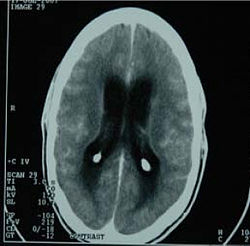Tuberculous meningitis

Editor-In-Chief: Prab R Tumpati, MD
Obesity, Sleep & Internal medicine
Founder, WikiMD Wellnesspedia &
W8MD medical weight loss NYC and sleep center NYC
| Tuberculous meningitis | |
|---|---|

| |
| Synonyms | N/A |
| Pronounce | N/A |
| Specialty | N/A |
| Symptoms | Headache, fever, neck stiffness, confusion, vomiting |
| Complications | Hydrocephalus, stroke, seizures |
| Onset | Gradual |
| Duration | Weeks to months |
| Types | N/A |
| Causes | Mycobacterium tuberculosis |
| Risks | HIV/AIDS, immunosuppression, malnutrition |
| Diagnosis | Lumbar puncture, CSF analysis, MRI |
| Differential diagnosis | Bacterial meningitis, viral meningitis, fungal meningitis |
| Prevention | BCG vaccine, tuberculosis control |
| Treatment | Antitubercular therapy, corticosteroids |
| Medication | Isoniazid, rifampicin, pyrazinamide, ethambutol |
| Prognosis | Variable, depends on stage at diagnosis |
| Frequency | More common in developing countries |
| Deaths | High if untreated |

Tuberculous meningitis is a form of meningitis caused by Mycobacterium tuberculosis, the bacterium responsible for tuberculosis. It is a serious condition that affects the meninges, the protective membranes covering the brain and spinal cord.
Signs and Symptoms[edit]
The symptoms of tuberculous meningitis can develop gradually over several weeks. Early symptoms may include fever, headache, nausea, and vomiting. As the disease progresses, patients may experience neck stiffness, confusion, seizures, and coma.
Pathophysiology[edit]
Tuberculous meningitis occurs when Mycobacterium tuberculosis spreads from the lungs to the central nervous system. The bacteria can enter the bloodstream and reach the meninges, causing inflammation and the formation of tuberculomas. This inflammation can lead to increased intracranial pressure and hydrocephalus.
Diagnosis[edit]
Diagnosis of tuberculous meningitis is challenging and often requires a combination of clinical assessment, cerebrospinal fluid (CSF) analysis, and imaging studies such as MRI or CT scan. CSF analysis typically shows elevated protein levels, low glucose levels, and a high white blood cell count with a predominance of lymphocytes.
Treatment[edit]
The treatment of tuberculous meningitis involves a prolonged course of antitubercular therapy (ATT), which includes drugs such as isoniazid, rifampicin, pyrazinamide, and ethambutol. Corticosteroids may also be used to reduce inflammation and prevent complications.
Prognosis[edit]
The prognosis of tuberculous meningitis depends on the stage at which treatment is initiated. Early diagnosis and treatment are crucial for a favorable outcome. Delayed treatment can lead to severe neurological damage or death.
Epidemiology[edit]
Tuberculous meningitis is more common in regions with high rates of tuberculosis, such as sub-Saharan Africa and Southeast Asia. It is also more prevalent in individuals with HIV/AIDS due to their compromised immune systems.
See also[edit]
References[edit]
<references group="" responsive="1"></references>
Ad. Transform your life with W8MD's Budget GLP-1 injections from $75


W8MD offers a medical weight loss program to lose weight in Philadelphia. Our physician-supervised medical weight loss provides:
- Weight loss injections in NYC (generic and brand names):
- Zepbound / Mounjaro, Wegovy / Ozempic, Saxenda
- Most insurances accepted or discounted self-pay rates. We will obtain insurance prior authorizations if needed.
- Generic GLP1 weight loss injections from $75 for the starting dose.
- Also offer prescription weight loss medications including Phentermine, Qsymia, Diethylpropion, Contrave etc.
NYC weight loss doctor appointmentsNYC weight loss doctor appointments
Start your NYC weight loss journey today at our NYC medical weight loss and Philadelphia medical weight loss clinics.
- Call 718-946-5500 to lose weight in NYC or for medical weight loss in Philadelphia 215-676-2334.
- Tags:NYC medical weight loss, Philadelphia lose weight Zepbound NYC, Budget GLP1 weight loss injections, Wegovy Philadelphia, Wegovy NYC, Philadelphia medical weight loss, Brookly weight loss and Wegovy NYC
|
WikiMD's Wellness Encyclopedia |
| Let Food Be Thy Medicine Medicine Thy Food - Hippocrates |
Medical Disclaimer: WikiMD is not a substitute for professional medical advice. The information on WikiMD is provided as an information resource only, may be incorrect, outdated or misleading, and is not to be used or relied on for any diagnostic or treatment purposes. Please consult your health care provider before making any healthcare decisions or for guidance about a specific medical condition. WikiMD expressly disclaims responsibility, and shall have no liability, for any damages, loss, injury, or liability whatsoever suffered as a result of your reliance on the information contained in this site. By visiting this site you agree to the foregoing terms and conditions, which may from time to time be changed or supplemented by WikiMD. If you do not agree to the foregoing terms and conditions, you should not enter or use this site. See full disclaimer.
Credits:Most images are courtesy of Wikimedia commons, and templates, categories Wikipedia, licensed under CC BY SA or similar.
Translate this page: - East Asian
中文,
日本,
한국어,
South Asian
हिन्दी,
தமிழ்,
తెలుగు,
Urdu,
ಕನ್ನಡ,
Southeast Asian
Indonesian,
Vietnamese,
Thai,
မြန်မာဘာသာ,
বাংলা
European
español,
Deutsch,
français,
Greek,
português do Brasil,
polski,
română,
русский,
Nederlands,
norsk,
svenska,
suomi,
Italian
Middle Eastern & African
عربى,
Turkish,
Persian,
Hebrew,
Afrikaans,
isiZulu,
Kiswahili,
Other
Bulgarian,
Hungarian,
Czech,
Swedish,
മലയാളം,
मराठी,
ਪੰਜਾਬੀ,
ગુજરાતી,
Portuguese,
Ukrainian